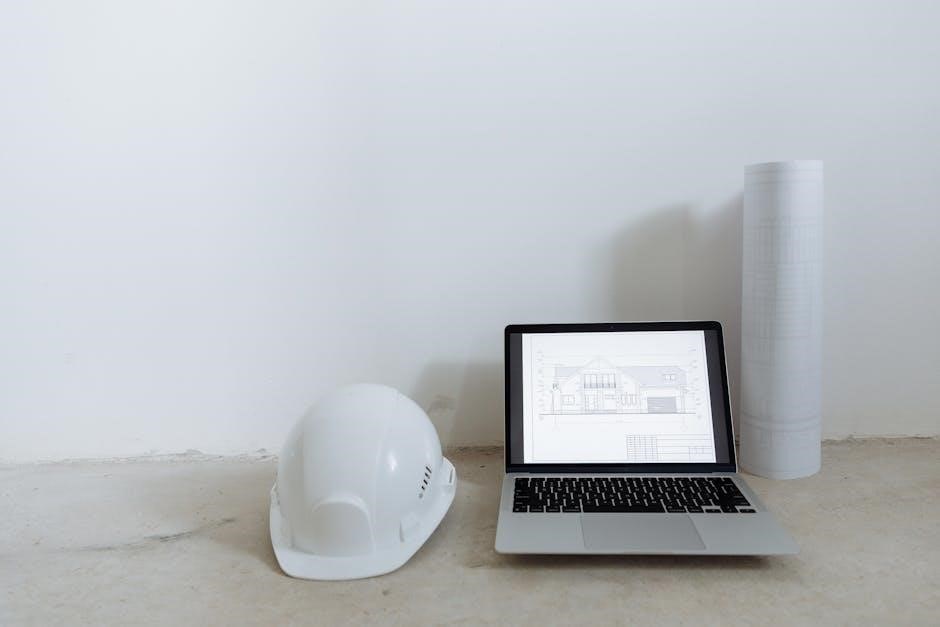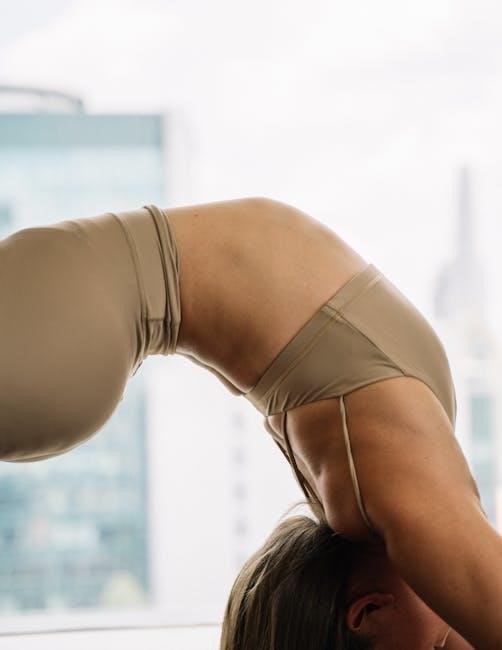
Unlock your glute potential with this comprehensive guide! Discover proven strategies, exercises, and nutrition tips to build strong, shapely glutes. Perfect for all fitness levels, this 4-12 week plan includes structured workouts, progressive overload techniques, and recovery methods to maximize results. Whether you’re a novice or experienced, this PDF offers everything needed to achieve your glute goals effectively.
1.1 Importance of Glute Development
Strong glutes are the foundation of lower body strength, enhancing posture, stability, and athletic performance. Weak glutes can lead to poor movement patterns and increased injury risk. Developing your glutes not only improves aesthetics but also boosts functional strength for daily activities and sports. A well-rounded glute workout plan ensures balanced muscle growth, preventing imbalances and promoting overall lower body health. Start your journey to stronger, shapelier glutes with a structured approach.
1.2 Benefits of a Structured Workout Plan
A structured workout plan ensures consistency and effectiveness, helping you maximize glute growth. It prevents muscle imbalances by targeting all three glute muscles evenly. With a clear schedule and progression strategy, you avoid plateaus and stay motivated. A well-designed plan also optimizes recovery, allowing muscles to grow stronger. By following a proven framework, you can achieve noticeable results faster and maintain long-term progress in your glute-building journey.

Understanding the Anatomy of the Glutes
The glutes comprise three muscles: Gluteus Maximus, Gluteus Medius, and Gluteus Minimus. Each plays a vital role in movement, stability, and posture, ensuring effective lower body functionality and balance.
2.1 Gluteus Maximus, Gluteus Medius, and Gluteus Minimus
The Gluteus Maximus is the largest muscle, responsible for hip extension and external rotation, making it essential for movements like squats and lunges. The Gluteus Medius stabilizes the pelvis during walking and running, preventing excessive hip tilt. The Gluteus Minimus assists in hip abduction and internal rotation, contributing to overall lower body balance and posture. Together, these muscles form a powerful system that supports both functional movement and athletic performance, making their development crucial for strength and aesthetics.
2.2 Role of Each Muscle in Movement and Posture
The Gluteus Maximus drives hip extension, powering movements like squats and deadlifts, while the Gluteus Medius and Minimus stabilize the pelvis during walking and running, preventing excessive tilt. These muscles work together to maintain proper posture, reduce lower back strain, and enhance overall athletic performance. Weakness in any of these can lead to imbalances, emphasizing the importance of targeting all three for functional strength and aesthetic goals in glute-building workouts.

Key Principles of Glute Building
Focus on selecting the best exercises, applying progressive overload, and maintaining a moderate rep range to optimize glute growth and prevent overtraining. Consistency is key.
3.1 Choosing the Best Exercises for Glute Growth
Selecting the right exercises is crucial for effective glute development. Compound movements like squats, deadlifts, and lunges target multiple muscle groups, while isolation exercises such as hip thrusts and glute bridges focus specifically on the glutes. Incorporating unilateral exercises like donkey kicks ensures balanced growth. Accessory workouts, including clamshells and frog pumps, enhance muscle activation. A well-rounded routine combining these exercises maximizes glute engagement and promotes overall strength and shape.
3.2 Progressive Overload and Its Significance
Progressive overload is essential for glute growth, involving gradual increases in weight, reps, or intensity over time. This ensures continuous muscle stimulation and adaptation. By challenging the glutes with heavier loads or higher volumes, you signal the muscles to grow stronger and larger. Consistent application of progressive overload prevents plateaus and accelerates results, making it a cornerstone of effective glute-building programs.
3.3 Moderate Rep Range for Optimal Results
A moderate rep range of 8-12 or 10-15 reps per set is ideal for glute growth, as it balances strength and hypertrophy. This range activates both fast-twitch and slow-twitch muscle fibers, promoting overall muscle development. Avoiding excessively low reps (e.g., 3-5) prevents overemphasis on strength alone, while high reps (20+) may focus too much on endurance. Consistent progression within this range ensures sustained glute growth and muscle definition.
Sample 4-Week Workout Plan Overview
This structured 4-week plan includes four days of targeted workouts, focusing on lower body strength, glute isolation, rest, and accessory exercises to maximize glute development effectively.
4.1 Day 1: Lower Body Focus
Day 1 focuses on compound exercises like squats, deadlifts, and lunges, which target the glutes, hamstrings, and quads. These movements build overall lower body strength and lay the foundation for glute growth. By incorporating weighted exercises, you engage multiple muscle groups, enhancing muscle activation and promoting balanced development. This day sets the stage for isolating glutes in subsequent workouts, ensuring a comprehensive approach to building strong, defined glutes effectively over time.
4.2 Day 2: Glute Isolation Exercises
Day 2 emphasizes glute isolation exercises like hip thrusts, glute bridges, and cable kickbacks. These movements target the gluteus maximus, medius, and minimus without relying on other muscle groups. By focusing on controlled, precise movements, you maximize glute activation and growth. This day complements the compound lifts from Day 1, ensuring a balanced approach to building strong, defined glutes. Proper form and full range of motion are key to effectiveness and safety.
4.3 Day 3: Rest or Active Recovery
Day 3 allows your glutes to recover and rebuild, crucial for growth. Opt for rest or light activities like stretching, yoga, or foam rolling to enhance blood flow. Active recovery helps maintain mobility without stressing the muscles. This balance supports muscle repair and prevents overtraining, ensuring you return stronger for future workouts. Prioritize relaxation and rejuvenation to maximize progress in your glute-building journey.
4.4 Day 4: Glute Activation and Accessory Work
Day 4 focuses on activating the glutes and targeting smaller muscle groups. Start with exercises like side-lying clamshells or hip abductions to engage the gluteus medius. Accessory work such as donkey kicks and frog pumps isolates the glutes, enhancing muscle activation. These movements improve balance, stability, and overall muscle engagement. Keep reps high (12-20) and weights moderate to maximize activation without overtaxing the muscles. This step is vital for building a strong, balanced posterior chain.

Nutrition and Diet for Glute Growth
A well-structured diet is essential for glute growth. Aim for a caloric surplus with sufficient protein, balanced carbs, and healthy fats. Stay hydrated and avoid processed foods for optimal results.
5.1 Importance of Caloric Surplus
A caloric surplus is essential for glute growth, as it provides the energy needed to build muscle. Ensure a slight surplus to fuel workouts and recovery. Pair this with sufficient protein to support muscle repair and growth. Track your intake to maintain consistency, and adjust as needed to avoid excess fat gain. A balanced surplus, combined with proper training, will accelerate your glute-building journey and deliver noticeable results over time.
5.2 Role of Macronutrients: Protein, Carbs, and Fats
Protein is vital for muscle repair and growth, while carbohydrates fuel your workouts. Fats support hormone production, which aids muscle development. Balancing these macronutrients ensures optimal energy, recovery, and growth. Aim for sufficient protein intake to repair glute muscles, use carbs for workout energy, and incorporate healthy fats to maintain hormonal balance. This balanced approach supports overall glute development and enhances workout performance effectively.

Accessory Workouts for Enhanced Glute Development
Accessory workouts target smaller muscle groups around the glutes, enhancing balance, posture, and injury prevention. They include exercises that strengthen supporting muscles for overall glute development.
6.1 Side-Lying Clamshells and Hip Abductions
Side-lying clamshells and hip abductions are excellent accessory exercises targeting the gluteus medius. They improve hip stability, posture, and overall glute development. Perform 3 sets of 15-20 reps with controlled tempo. These unilateral movements help prevent muscle imbalances and enhance compound exercises like squats and deadlifts. Incorporate them into your routine for stronger, more balanced glutes. Ideal for activating smaller muscle groups, these exercises support injury prevention and promote balanced growth.
6.2 Donkey Kicks and Frog Pumps
Donkey kicks and frog pumps are highly effective for targeting the gluteus maximus and improving muscle activation. Donkey kicks strengthen the glutes while promoting proper hip alignment, while frog pumps enhance glute-hamstring coordination. Perform 3 sets of 15-20 reps with controlled tempo. These exercises are perfect for isolating the glutes, reducing lower back strain, and adding diversity to your workout routine. They’re ideal for building a rounder, stronger posterior with consistent practice and proper form.
The Role of Hip Thrusts in Glute Building
Hip thrusts are highly effective for targeting the gluteus maximus, enabling heavy loading and promoting significant muscle growth. They improve hip extension strength, essential for functional movement and overall lower body development.
7.1 Why Hip Thrusts Are Highly Effective
Hip thrusts isolate and activate the glutes intensely, making them a cornerstone of glute-building routines. They allow for heavy loading, promoting muscle growth and strength. By targeting the gluteus maximus, hip thrusts enhance both aesthetics and functional movement. Their effectiveness lies in their ability to maximize muscle fiber engagement while minimizing unnecessary strain on other muscle groups, making them a must-have exercise for optimal glute development.
7.2 Step-by-Step Guide to Performing Hip Thrusts
Position yourself on a flat bench with your knees bent and feet flat. Place your hands by your hips for support. Engage your core, lift your hips, and squeeze your glutes at the top. Lower slowly to the starting position, maintaining control throughout. Avoid rounding your lower back. Focus on full range of motion and proper form to maximize glute activation and prevent injury.
Progressive Overload Strategies
Progressive overload ensures continuous glute growth by gradually increasing weight or reps. Consistency is key to achieving muscle development and strength gains over time;
8.1 Increasing Weight Gradually
Gradually increasing weight is essential for glute growth. Start with manageable loads and add small increments weekly to challenge muscles without risking injury. This sustainable approach ensures consistent progress and avoids plateaus. Focus on compound exercises like weighted hip thrusts and deadlifts, tracking progress in a workout log to stay motivated and monitor improvements over time.
8.2 Enhancing Training Volume Over Time
Increasing training volume over time is crucial for sustained glute growth. Aim to add more sets, reps, or exercises weekly to challenge muscles further. Introduce variations like weighted hip thrusts or heavier deadlifts to keep the glutes engaged. Gradually extend rest intervals to handle higher intensity. This progressive approach ensures continuous muscle stimulation, promoting strength and size gains without plateauing. Consistency and patience are key to long-term success.
Active Recovery for Glute Health
Active recovery is essential for maintaining glute health. Techniques like foam rolling, stretching, and yoga help reduce muscle tension, improve flexibility, and promote overall muscle balance.
9.1 Foam Rolling and Stretching Techniques
Foam rolling and stretching are crucial for glute recovery. Foam rolling improves blood flow, reduces muscle tension, and enhances flexibility. Focus on rolling the piriformis, glutes, and IT band. Stretching exercises, such as hip flexor stretches and glute bridges, help maintain muscle balance and prevent tightness. Incorporating these techniques regularly ensures optimal recovery, allowing your glutes to grow stronger and healthier. Consistency is key to maximizing results and avoiding injury.
9.2 Incorporating Yoga for Muscle Balance
Incorporating yoga into your glute-building journey enhances muscle balance and flexibility. Poses like downward dog, pigeon, and child’s pose target the hips and lower back, reducing muscle tension. Yoga improves posture, alignment, and mental focus, ensuring workouts are performed effectively. It also promotes recovery by increasing blood flow and relaxation. Balancing strength with flexibility through yoga supports overall muscle development and prevents imbalances, making it a valuable addition to your glute workout plan.
Embark on your glute-building journey with confidence! This comprehensive guide provides a clear roadmap to achieving strong, defined glutes. Stay dedicated, and celebrate your progress along the way.
10.1 Recap of Key Points
Building strong glutes requires a structured workout plan, progressive overload, and proper nutrition. Focus on compound exercises like squats and hip thrusts, and incorporate isolation exercises for targeted growth. Maintain a caloric surplus, balance macronutrients, and allow time for recovery. Consistency and patience are key to achieving your glute goals. Refer to the provided PDF for detailed workout schedules, exercise guides, and nutrition advice to ensure success on your fitness journey. Stay motivated, track your progress, and celebrate small victories to maintain momentum. With dedication, you’ll see noticeable improvements in strength and shape over time.
10.2 Motivation to Start the Glute Building Journey
Embark on your glute-building journey with confidence! This transformative process not only enhances your physique but also boosts strength and posture. Every rep and healthy meal choice brings you closer to your goals. Remember, this journey is about self-improvement and empowerment. With dedication and the right guidance from your workout plan, you’ll achieve remarkable results. Start today, stay consistent, and embrace the strong, confident version of yourself waiting to shine!





